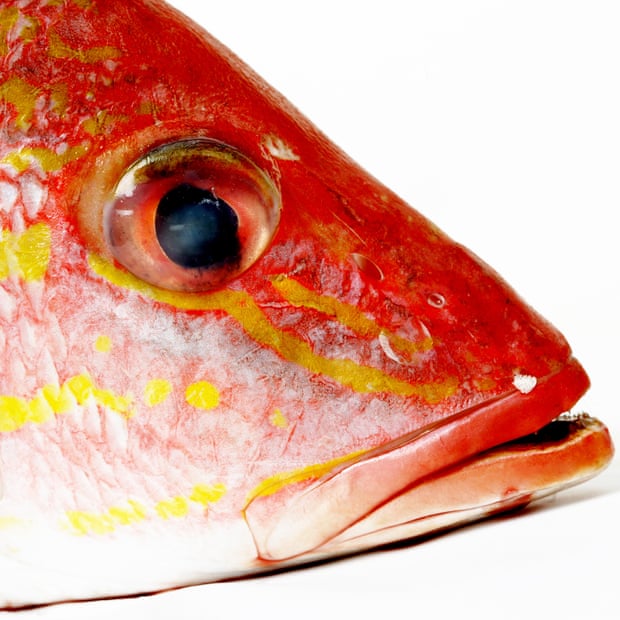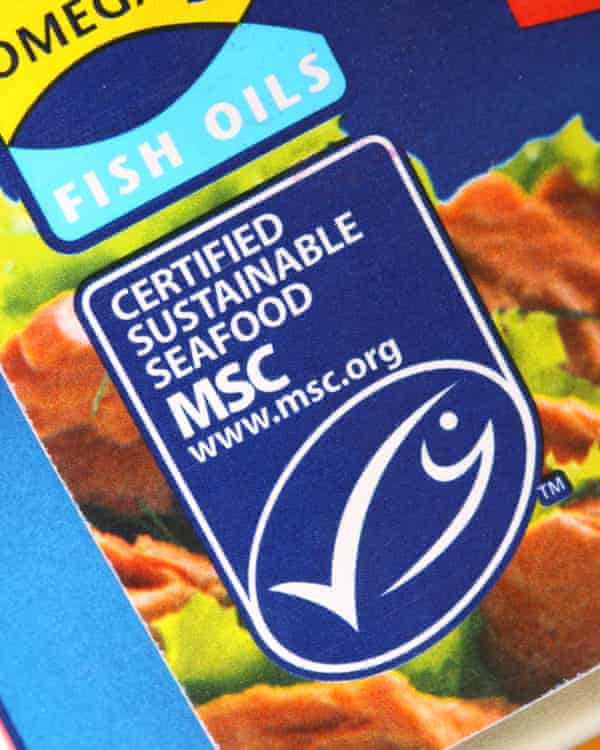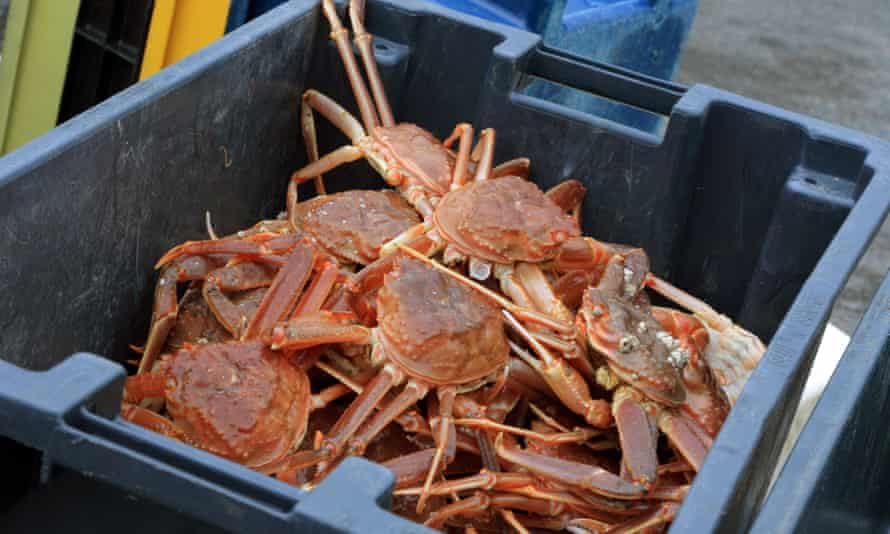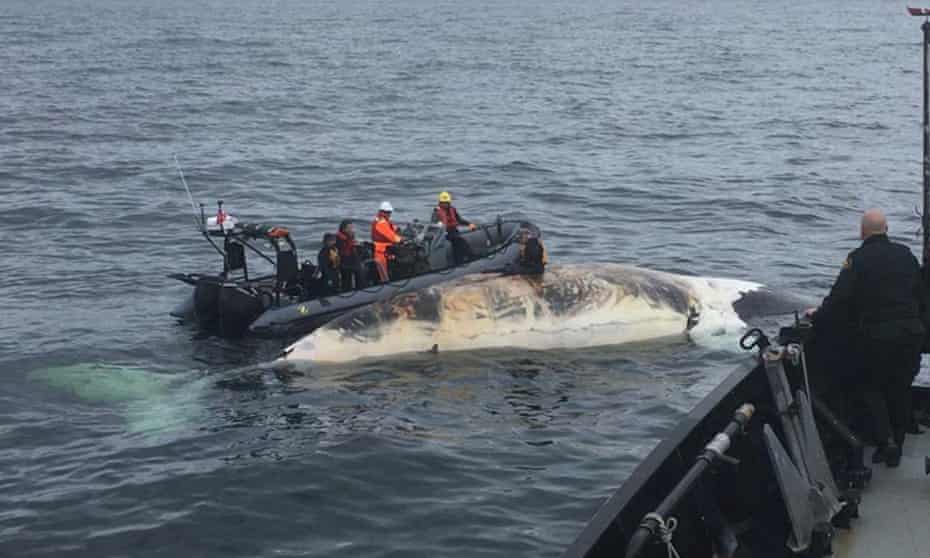Blue ticked off: the controversy over the MSC fish ‘ecolabel’

The MSC’s coveted blue tick is the world’s biggest, and some say best, fishery ecolabel. So why is it in the headlines – and does it really do what it says on the tin?
Last modified on Mon 26 Jul 2021 01.01 EDT
This month, two right whales in the Gulf of St Lawrence were found entangled in fishing gear. One, a female, was first spotted entangled off Cape Cod last year, but rescuers were not able to fully free her; the other, a male, is believed to have become entangled in the Gulf.
Hunted to near extinction before a partial whaling ban in 1935, North Atlantic right whales are once more critically endangered, with only 356 left. The main threat remains human contact: entanglement in fishing gear, and ship strikes. Fatal encounters, caused in part by the whales’ migratory shift into Canada’s snow crab grounds, have soared: more than a tenth of the population died or were seriously injured between 2017 and 2021, mostly in Canada and New England.
One of the threats they face is from the growing crab and lobster fisheries. The whales migrate from their calving grounds in Florida to feed in Canada – putting them on a collision course with the pots and traps.

“We’re talking millions of lines, placed in the water every year,” says Kate O’Connell, a marine wildlife consultant for the Animal Welfare Institute. “These animals are running the gauntlet – and it’s getting harder and harder for them to survive.”
When a whale gets entangled, ropes from buoys on the surface to the seabed traps can become embedded in its skin, weighing it down and leaving it unable to swim or feed properly, leading to a “really traumatising death”, O’Connell says.
But what makes it even more concerning to conservationists is that some of the fisheries they say threaten the right whale were certified as “sustainable” by the world’s largest fisheries certification programme: the Marine Stewardship Council.
The MSC, which grants the right to use its well-known “blue tick” label on products, has grown from 315 certified fisheries in 2017 to 421, representing 14% of all global fish landings. In the last year its labelled products were worth $12bn (GBP9.5bn). In the absence of governments looking after our oceans, “the MSC is definitely the best we’ve got” in terms of consumer labels, according to Ruth Westcott of the environmental alliance Sustain.
The MSC hit the headlines in March, however, when the controversial Netflix documentary Seaspiracy accused it of certifying fisheries with a high level of “bycatch” – whereby species such as dolphins and turtles are caught in fishing nets – and said its certification was too easily achieved.
The MSC denied the allegations and, alongside several other organisations, accused the film-makers of making “misleading” claims. The producers deny this.
But the plight of right whales shows how fine a line the MSC has to walk, between conservationists and the fishing industry, and has reignited a fierce debate over what it means when you see a blue MSC label on a fish package in the supermarket.
Certainly, the presence of MSC-certified fisheries along the migration route of one of the world’s most endangered mammals has become emblematic of the contradictions the organisation has to confront. Even one dead whale a year brings the species closer to extinction.
Another ecolabel, from the conservation group WWF, takes a different tack. This month, WWF Hong Kong revised its seafood guide to downgrade “Boston lobster”, the generic Chinese term for all two-clawed American lobster species, to “red/avoid” because its harvesting grounds overlap with the habitat of North Atlantic right whales.
Why then, conservationists say, would MSC give any fishery in the right whales’ range the green light to fish there?
Q&ASeafood labelsShow

Marine Stewardship Council’s blue tick
Seafood with a blue tick from the MSC can be traced back to a fishery that is certified as sustainable, based on whether the stock is heathy and well managed and whether the fishery is minimising its impact on other species and the wider ecosystem. To be certified fisheries must submit to and pay for an independent audit.
Marine Conservation Society’s good fish guide
The UK-based MCS runs a regularly updated “good fish guide” to advise consumers on which seafood is most sustainable. The best scientific advice available is used to create a traffic-light system of ratings from 1-5, in which one is “best choice” and five is “fish to avoid’, based on the health of the population, how fishing is controlled and the effects on the wider environment. An existing certification with MSC can improve the scores.
Monterey Bay Aquarium Seafood Watch
A US-based advisory list, along the same traffic-light system as the MCS’s good fish guide. It defines sustainable seafood as that which comes from sources that can maintain or increase production without jeopardising the structure and function of affected ecosystems.
WWF
WWF, like MCS and the MBA, draws from the best available scientific data to provide seafood guides of the most sustainable fish to choose in several countries, based on species type.
Critics also argue that the very nature of the MSC’s model, with fisheries paying to be certified, poses a conflict of interest.
Is the MSC, the world’s biggest fisheries certification scheme, still fit for purpose?
The heart of the matter may come down to the fact that the MSC exists not just to protect the environment but also to ensure thriving fisheries.
Rupert Howes, MSC chief executive, says it is about “resource management”, not pure conservation.

“We’re passionate about oceans and marine ecosystems and ocean resilience,” he says, “but we’re also deeply concerned about global food insecurity and indeed the 500m livelihoods the FAO [UN Food and Agriculture Organization] estimate depend on the global seafood industry.”
He admits that the organisation is “not perfect”, and says the level of criticism is “difficult”.
“There’s a tendency for everybody to want us to resolve their particular issues,” Howes says. “And there’s a limit. We’re already complex and costly compared with other assurances.” He is at pains to point out what the MSC does well: “Nothing carries the label without traceability. Nothing carries the label without a recertification every five years, and the audit every year.”
He argues that the MSC system is vastly superior to the industry self-certifying; he also notes that, while some organisations are promoting improvement projects, many have no traceability, action plan or outcome. Unlike some other ecolabels, with “desk-based research”, Howe says, the MSC works with fisheries to “drive improvements”.
“Stakeholders sometimes feel because we’re working with the markets that it’s compromised, but it isn’t,” he says.
To be certified by MSC takes up to 18 months. First, a fishery is assessed by independent “conformity assessment bodies” (CABs). They visit the fishery, consult experts and consider all available data to decide whether it meets MSC criteria. There are several checks and balances, including third-party monitoring of the CABs and an independent evaluation of the assessment. In addition, environmental organisations can object to certification, which often results in additional conditions placed on fisheries.
Sixteen of its 421 fisheries are currently suspended, including the Gulf of Maine lobster fishery and the Gulf of St Lawrence snow crab fishery, which has now withdrawn from the MSC altogether. In the past five years, a quarter of all new assessments ended without certification. But since 2001, MSC said it had received 51 objections before certification, which resulted in three fisheries not being certified.
Howes believes the market model is driving a more sustainable ocean. “The MSC is just trying to empower consumers to do their part to reward, in our mind, the ones that are doing the right thing.”
But the right thing means different things to different people. Scores of organisations have expressed concern that the MSC’s certification process does not properly account for bycatch, particularly of sharks and cetaceans. In 2018, a group of 66 conservation groups and academics accused the MSC of not paying enough attention to the protection of species not specifically targeted by fisheries.

Conservationists argue the MSC lacks a “gut check” on endangered species – and right whales are a good example. In 2017, due to threats to endangered species, O’Connell and 53 international organisations urged the MSC to reassess a number of fisheries, including the Gulf of Maine lobster fishery. The same year, the MSC suspended a “sustainable” snow crab fishery, the Gulf of St Lawrence, after right whales were found dead in its fishing gear. But it did not suspend the lobster fishery until 2020, after the federal judge had ruled that US fishing authorities had overlooked the impact of lobster fisheries on right whales.
The MSC argues that certification is “part of the solution” to right whale entanglement because it drives good practice, such as monitoring and taking steps to avoid interactions. In the case of the right whales, the CABs that certified the fisheries in question have said there is “no evidence” of them causing a threat, and that it imposed conditions on some to “monitor and reduce the risk”.
Since the Gulf of St Lawrence deaths and suspension in 2017, “there have been no reports of right whale deaths within an MSC certified fishery”, according to the MSC. Its fisheries used colour-coded gear, it said, to identify which fishery was responsible for any entanglements that occur, and if issues arose it could audit and investigate quickly.
Last month, however, a paper co-authored by Amy Knowlton, a senior scientist at the Anderson Cabot Center for Ocean Life at the New England Aquarium, reported an alarming reduction in the size of right whales, suggesting their stunted growth could be the result of hauling around fishing gear. It is estimated that 85% of right whales have suffered at least one entanglement.
“A lot of fisheries are in denial they are part of the problem,” says Knowlton. One of her biggest concerns, she says, is the “need to get this firm evidence before a fishery will do anything. We don’t know where the majority of these entanglements occur but we do know they occur throughout the range.”
Today, six lobster and snow crab trap and pot fisheries within the right whales’ range remain MSC-certified as “sustainable”. But none of them should be, in O’Connell’s opinion, given the cumulative risk from multiple fishing lines. The MSC’s guidelines “remain weak”, she says, and are in desperate need of a thorough review.
The MSC says it is doing just that: undertaking a review of the fishery standard on which it bases its certification.
As part of the review, it has proposed a “more precautionary approach” to endangered, threatened and protected (ETP) species, says Rohan Currey, the MSC’s chief science and standards officer. Every marine mammal, reptile, amphibian and seabird would now all be regarded as ETP species, “irrespective of how abundant it is”.
This would, says Currey, trigger a condition for certified fisheries to reduce its bycatch, or unintentional catch, of these animals.
He says the review will examine the possibility of including sharks and other species, and also look at requirements for independent data collection – for instance, using observers or electronic monitoring – as well as potentially broadening the criteria for cumulative risks to a fishery.
The review will end in 2022. However, because of the FAO’s rules allowing fisheries three years to comply, any changes would not be likely to take effect until at least 2023 for new fisheries – and 2025 for those already in the scheme.
In the meantime, the MSC’s own advisory council is growing concerned. Rory Crawford, of BirdLife International, one of the advisory council stakeholders, conducted a study of 23 fisheries in 2019 and found that only three were actively working to monitor and minimise bycatch.

“Consumers cannot be fully confident that certified fish comes without impacts on non-target species, from sharks to seabirds to whales,” he concluded.
Given that standards have not changed since 2019, he says, there are still MSC-certified fisheries that are not doing their best to minimise seabird bycatch, such as bird scaring or weighted lines.
“As a consumer purchasing a blue-tick product, I’d want to know that every effort was being made to minimise or even eliminate non-target bycatch, irrespective of whether it’s a ‘critically endangered’ Tristan albatross or ‘least concern’ common guillemot,” he says.
Ruth Westcott, campaign coordinator at the environmental alliance Sustain, says that in the absence of governments looking after our oceans, “the MSC is definitely the best we’ve got” in terms of labels. While the system has failed, it was “not all doom and gloom” for the consumer, she said. “As a consumer, you can buy from fishmongers or direct from a fishery – as close to the source as possible. Then look at the MSC or MCS rating scheme.”
Crawford notes that MSC certification has resulted in improvements for some fisheries, such as the Namibian hake, where seabird bycatch fell by 90% . He wants the MSC to require independent data, as well as explicit requirements that fisheries minimise bycatch of species of “least concern”, such as eider ducks and northern Fulmars, which fisheries catch in their thousands.
WWF, which co-created the MSC scheme two decades ago, is perhaps the highest-profile organisation calling for it to reform.
WWF has already lodged objections to several proposed certified fisheries, and says the MSC should be “more rigorous” in its standards, and needs to apply the “precautionary principle” as a matter of course. Last year, WWF and the Pew Charitable Trusts objected to the MSC’s certification of its first bluefin tuna fishery, saying it was too early to declare the stock fully recovered. An audit of the assessment of the fishery identified “minor nonconformity” issues, including around the impartiality of the CAB, which MSC said had since been addressed.
“I would not trust all of the fisheries to be sustainable,” says Giuseppe Di Carlo, WWF’s director of the WWF Mediterranean marine initiative. “WWF expects MSC to make reforms in the standard, and also in the assurance process, the implementation of standards.”
He says there is a conflict of interest at the heart of the scheme because the fisheries pay the CABs fees of $20,000 to $500,000 for the assessment. The MSC also charges retailers royalties of up to 0.5% of the net wholesale value of seafood sold, for using its label.
The MSC says any risk is mitigated by numerous reviews and consultations to ensure all the evidence is fairly and correctly interpreted. A formal objection process is also available for further scrutiny, it says.
In the meantime, it is likely to be four years before most fisheries will be pressed to make any improvements at all – assuming the MSC review even recommends they do so.
“Drastic changes are going on: increasing biodiversity loss, climate change, overfishing,” says O’Connell. “Right whales don’t have time for all this to be figured out. They’re coming to the point where they will hit a tipping point, and it will be too late.”
However, MSC insisted action was already being taken and said: “It is not a case of waiting for the outcome of the fisheries standards review to help right whales.”
As for the bigger picture, says Michelle Cho, a specialist in bycatch at the Anderson Cabot Center, the MSC needs to take a hard look at itself.
“There’s a lot of criteria they need to follow, there are the assessment bodies, and they have their guidance on how to score things,” says Cho. “But a lot of us feel that ‘gut check’ is not there.
“If things are cumulatively contributing to a species going extinct, is that really sustainable?”
